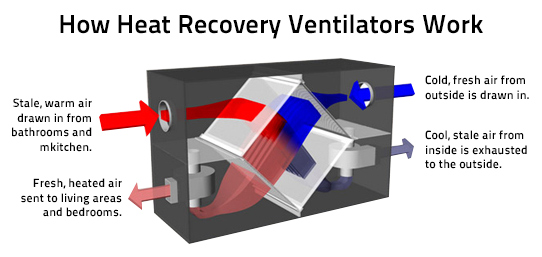The All-Inclusive Overview to the Uses of Heat Recovery Ventilation in Modern Buildings
Heat Recovery Ventilation (HRV) systems represent a considerable advancement in developing technology (HRV Heat Recovery Ventilation). They offer a technique for exchanging stale indoor air with fresh outdoor air while minimizing energy loss. This method not just boosts interior air quality but likewise adds to energy effectiveness in both residential and industrial structures. Recognizing the various applications and benefits of HRV can disclose its crucial role in contemporary layout and sustainability initiatives. The effects of this modern technology are worth exploring even more
Comprehending Heat Recovery Ventilation Equipments

Lots of modern-day structures focus on energy efficiency, recognizing heat recuperation ventilation (HRV) systems is vital for maximizing interior air top quality and decreasing energy intake. HRV systems work by transferring heat from stagnant interior air to inbound fresh air, efficiently preserving comfy indoor temperatures while reducing energy loss. These systems include a warmth exchanger, followers, and ductwork that help with the blood circulation of air. During winter, HRV systems catch and reuse warm from the outgoing air, while in summer season, they can aid cool incoming air. By constantly trading air, HRV systems additionally reduce humidity and the focus of indoor pollutants. Appropriate installation and upkeep of HRV systems are vital for their effectiveness and performance in improving overall building efficiency and comfort.
Advantages of Heat Recovery Ventilation
Heat recovery ventilation systems offer various advantages that enhance both energy performance and interior air quality in modern buildings. By recording and recycling power from exhaust air, these systems substantially minimize heating & cooling costs, leading to lower power consumption. They preserve a stable circulation of fresh exterior air, lessening the risk of interior air contaminants and allergens. This continuous exchange helps manage humidity degrees, stopping mold and mildew growth and guaranteeing a healthier living environment. Furthermore, HRV systems add to sustainability objectives by reducing general carbon impacts. Their capacity to maximize air flow without compromising thermal comfort makes them an important enhancement to modern structure design, advertising both financial and ecological benefits.
Applications of HRV in Residential Structures
As house owners increasingly focus on energy performance and indoor air top quality, the applications of warmth healing ventilation (HRV) systems in household structures have actually become more widespread. HRV systems are specifically beneficial in tightly sealed homes, where keeping fresh air blood circulation is necessary for avoiding moisture build-up and indoor contaminants. They efficiently transfer warmth from outbound stale air to inbound fresh air, lowering energy expenses connected with cooling and heating. Furthermore, HRVs can boost comfort degrees by regulating moisture and temperature level. They are additionally versatile for numerous household layouts, including single-family homes and multi-unit buildings. Overall, integrating HRV systems supports lasting living techniques while ensuring a healthier indoor setting for residents.
HRV in Commercial and Industrial Setups
In business and industrial settings, the implementation of warmth recuperation ventilation (HRV) systems has actually become significantly essential for optimizing energy performance and keeping air high quality. These systems successfully move heat from exhaust air to incoming fresh air, reducing the requirement for added heating or air conditioning. This not just decreases power prices however likewise contributes to sustainability campaigns. Industries such as production, warehousing, and office structures profit considerably from HRV systems, as they aid control temperature and moisture degrees, guaranteeing a comfortable and efficient atmosphere. Moreover, HRV systems aid in getting rid of pollutants and excess wetness, enhancing indoor air top quality. As policies around air top quality end up being more stringent, the fostering of HRV technology is most likely to expand, making it an important component of modern commercial and industrial facilities.
Future Patterns in Heat Recovery Ventilation Modern Technology

Frequently Asked Inquiries
Exactly How Does Heat Recovery Ventilation Impact Indoor Air Quality?
Heat recovery ventilation significantly boosts interior air quality by continually trading stale indoor air with fresh outside air while recovering power. This process decreases contaminants, maintains excellent moisture levels, and assures a much healthier setting for residents.
Can HRV Solutions Be Mounted in Existing Buildings?
HRV systems can undoubtedly be set up in existing buildings. Retrofitting might need modifications to ductwork and ventilation layouts, yet it significantly enhances energy efficiency and interior air high quality, making it a feasible option for older frameworks.
What Maintenance Is Required for HRV Solutions?

Are There Certain Climates Where HRV Is A Lot More Effective?
Heat recovery ventilation systems are particularly effective in climates with considerable temperature level distinctions in between periods. These systems optimize power efficiency by recuperating heat from exhaust air, making them optimal for both cool and reasonably cozy atmospheres.
Exactly How Do HRV Systems Affect Power Expenses?
